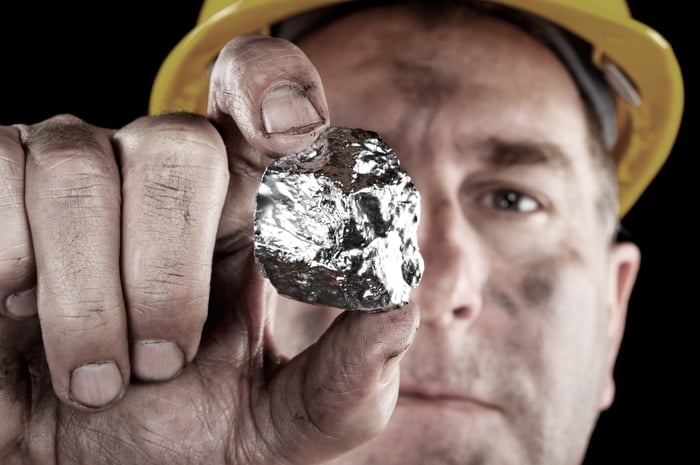The stock market has nothing on cryptocurrency when it comes to stellar gains. While the S&P 500 index more than doubled in value in less than 18 months from the low point of the pandemic to its recent high, the total cryptocurrency market cap has risen from $163 billion to almost $2.7 trillion.
And more new cryptos are born every day. At the time of this writing, 30 new cryptocurrencies were added in just the last 12 hours alone. Not all of them will be worth your time, especially those named after a certain dog. And in fact, most probably won't be.

Image source: Getty Images.
Even among the biggest, better-known coins, very few likely have long-term viability. Which is why, if you're interested in investing in the sector, you should be very circumspect about where you put your money.
Yet there are some good reasons some of them will be winners that could return five, 10, or even 20 times your original investment. Here's one that has a better chance than most after its value was dramatically cut.

Image source: Getty Images.
Making crypto accessible to the masses
Bitcoin (CRYPTO: BTC) was the first widely adopted cryptocurrency, and for that reason alone it remains the most popular and most valuable of coins.
Having been skeptical of its staying power, I remember telling a friend who bought Bitcoin between $600 and $900 to sell, sell, SELL!! when it hit $7,000, and that he was a fool for holding on to it at $15,000. Let's just say I'm the one sitting with egg on my face today.
Today, Bitcoin is probably as mainstream as it gets, with companies like Tesla buying and accepting the coin, and asset managers like Grayscale Investments owning a sizable portion of bitcoin for the Grayscale Bitcoin Trust. However, its attempt to create an exchange traded fund (ETF) linked to derivatives contracts, not actual bitcoin, has so far been thwarted by the SEC.
The popularity and success of Bitcoin paved the way for the 7,858 other cryptocurrencies that exist today.
Yet it's not the only one, and arguably not even the best crypto, despite often being considered the gold standard of the industry. Instead, you might want to consider crypto's "silver standard," Litecoin (LTC 0.44%).

Image source: Getty Images.
A better bitcoin
Charlie Lee, Litecoin creator and founder of the Litecoin Foundation, describes the coin as a "light version of Bitcoin" as it was created from a modified version of Bitcoin's source code. So while the two share a certain heritage, there are some important differences, notably its hashing function, speed of block generation, and availability of supply.
I won't pretend to understand all that goes on under the hood of coin creation, but the hashing function of a cryptocurrency is essentially the conversion of any form of data into a unique string of text to safeguard the data. Unlike encryption, hashing really can't be reverse engineered, or decrypted. It's a one-way road.
Also according to Lee, new blocks on the Litecoin network are generated every 2.5 minutes on average, or some four times faster than the Bitcoin blocks, which are being mined about every 10 minutes.
He also points out that where the total universe of Bitcoin is around 21 million tokens, there are 84 million litecoins, making it much more accessible. That's why he called it "the silver to Bitcoin's gold."

Image source: Getty Images.
The silver lining
While real gold does have its commercial uses, it is more often seen as a store of value. Silver, on the other hand, is actually much more important because beyond its value as a precious metal, it has vital industrial, technological, and consumer uses, especially in automobiles, solar panels, and (of course) jewelry.
Think of Litecoin in the same way. It was designed to be mined through use of consumer-grade computers, not the more-specialized processors typically used to harvest the power-hungry Bitcoin applications. Its hashing function also makes it easier for individual investors.
As a result, Litecoin is the 15th most-valuable cryptocurrency with a market capitalization of nearly $15 billion as of Dec. 1 and a per-token value of $216. It is also the third most widely held cryptocurrency by institutional investors behind Bitcoin and Ethereum.
A full-bodied opportunity
Litecoin tripled in value this year before tumbling 45%, putting it at an enticing price, seen as undervalued based on its correlation with Bitcoin. At least one analyst foresees a $1,500 price for Litecoin, even though it's been three years since it hit its all-time high of $420.
What could be the catalyst for Litecoin to rise in value over time is Litecoin halving, or the process by which the supply of the coin is controlled. After 840,000 blocks are mined the amount of Litecoin miners are rewarded with is halved. It occurs approximately every four years and is built into its algorithm.
Two halvings have occurred so far, the next is expected in late 2023. After halving, prices are expected to grow because fewer miners work to mine new coins since they receive less compensation. It continues until the coin price offers a great enough incentive and the miners return to the network. It's the regulation of the supply and the forced scarcity of Litecoin that could be its greatest lever.
Certainly Litecoin is more speculative than Bitcoin or Ethereum, but because it is a more convenient and economical option for cryptocurrency investors, even if Litecoin doesn't reach such stratospheric levels, investors might still want to dig into this silver-medal finalist.





